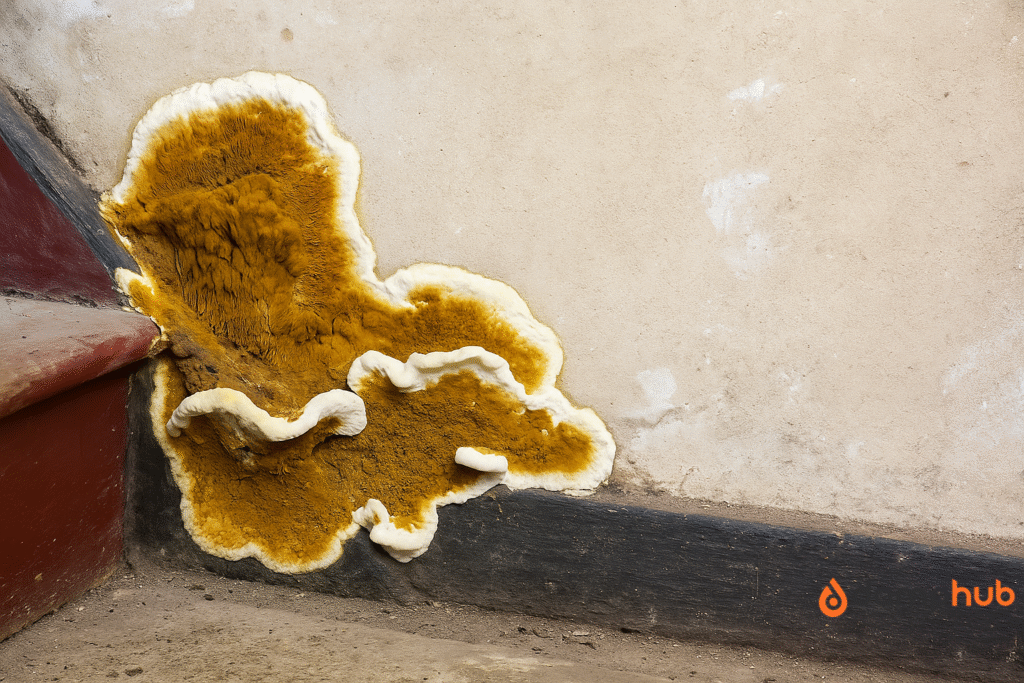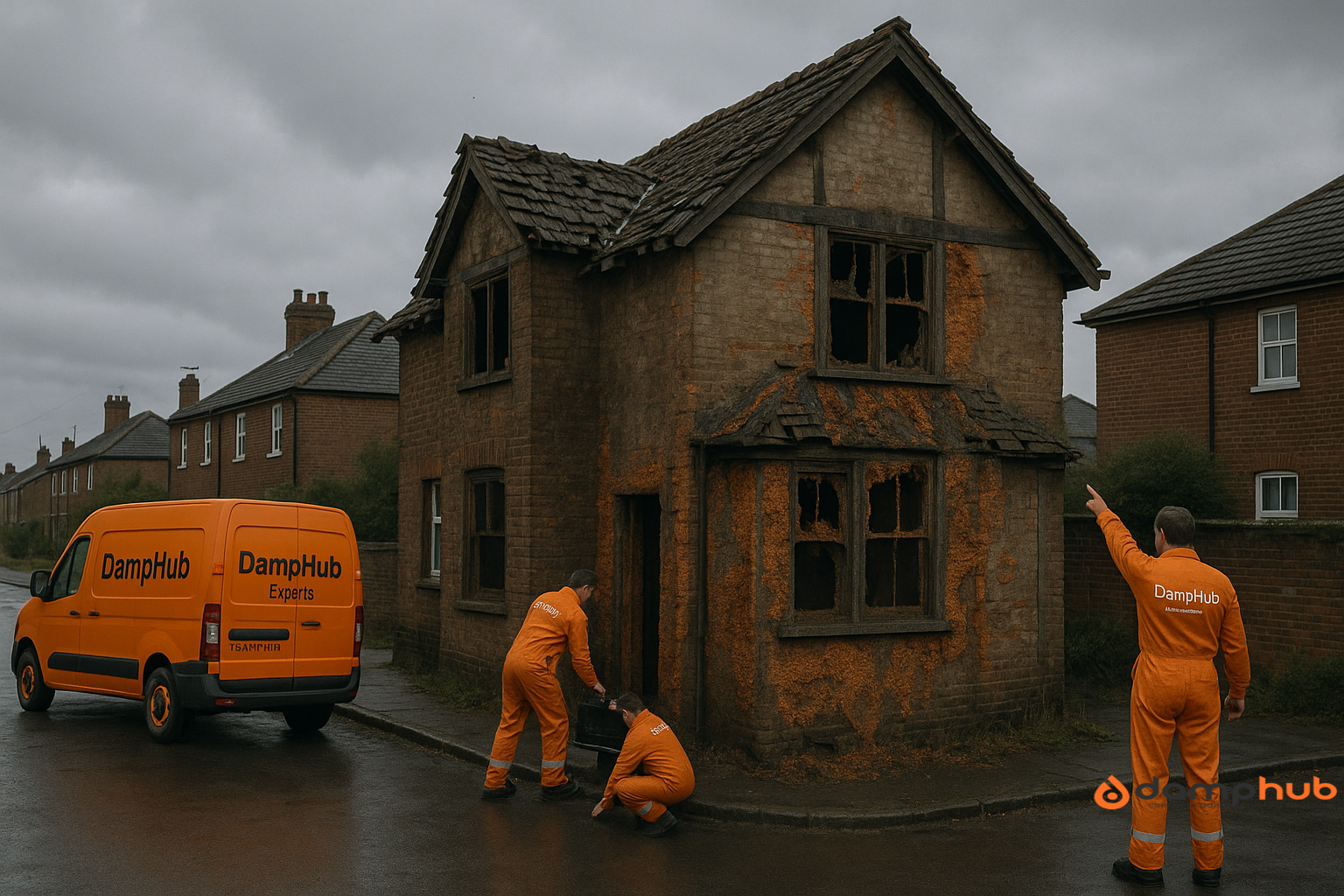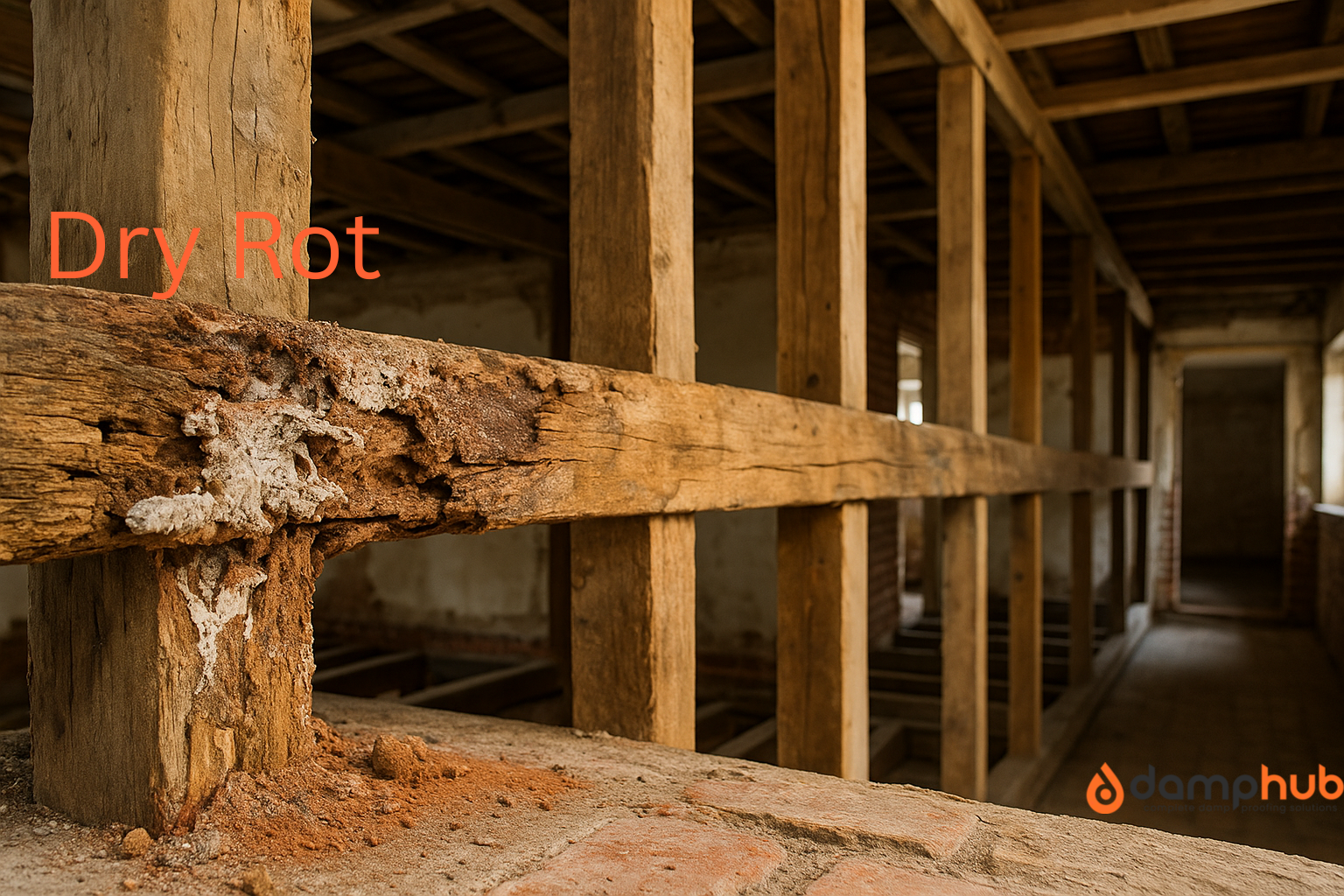
Dry rot is one of the most damaging and costly forms of timber decay in UK properties.
Caused by a specific type of wood-destroying fungus (Serpula lacrymans), dry rot can compromise structural integrity if left untreated.
The good news?
Early identification and effective dry rot treatment can stop the damage and save you thousands in repairs.
In this guide, we’ll explore how to spot dry rot, treat it, and prevent it from coming back, with resources tailored for UK homeowners and property managers.
What Is Dry Rot?
Dry rot is a type of fungal decay that attacks timber in damp, poorly ventilated areas.
Despite its name, dry rot requires moisture to develop, typically in conditions where wood has a moisture content of 20% or more.
Once established, the fungus can spread rapidly through masonry and timber, even affecting areas that appear dry.
The fungus breaks down the cellulose and hemicellulose in wood, leaving it weak, brittle, and structurally unsound.
Left unchecked, dry rot can spread silently behind walls and under floors, making it particularly dangerous in older homes and buildings.
Dry Rot vs Wet Rot:
- Dry Rot: More aggressive, spreads beyond the damp source, can migrate through masonry, produces airborne spores that accelerate spread.
- Wet Rot: Confined to the area of moisture, generally easier to treat, but still damaging if not addressed.
Understanding the difference is crucial when selecting the appropriate treatment method.
For technical guidance on timber decay, see Historic England’s report on fungal decay.
How to Identify Dry Rot in Your Home
Identifying dry rot early can save significant repair costs and prevent the need for major structural work.
Since it often starts in hidden areas, regular inspection and awareness of key signs are essential.
Signs of Dry Rot:
- Musty, damp smell: Often the first sign, caused by fungal activity.
- Cuboidal cracking in wood: Timber breaks into cube-like pieces.
- Brittle, crumbling wood: Wood loses strength and disintegrates on contact.
- Rust-coloured spore dust: Indicates the fungus is reproducing.
- Silky grey-white mycelium: Thread-like growths that spread across wood, brick, and plaster.
- Fruiting bodies (sporophores): Mushroom-like structures that release spores and signal a mature infestation.
👉 Read our full guide: Identifying Dry Rot Symptoms

Common Locations:
- Subfloor voids and under floorboards
- Behind skirting boards and wall panelling
- Inside lofts, attics, and crawl spaces
- Around leaking plumbing, roofs, or guttering systems
Homeowners should be especially vigilant in properties with past damp problems or limited ventilation.
Learn more about spotting dry rot at the Property Care Association.
Dry Rot Treatment: Step-by-Step Guide
Effective dry rot treatment requires a comprehensive approach that not only eliminates the visible fungus but also addresses the root cause—excess moisture.
1. Identify the Moisture Source
Investigate plumbing leaks, rising damp, roof issues, and blocked gutters. Using a professional damp survey can pinpoint hidden causes.
2. Remove Infected Materials
All timber, plaster, and debris showing signs of dry rot must be removed.
In some cases, unaffected timber within a 1m radius is also removed to prevent future spread.
3. Apply Fungicidal Treatment
After removal, apply a high-quality fungicide (often boron-based) to the surrounding masonry, timber, and hidden cavities.
Reputable products will be compliant with UK biocide regulations.
4. Replace with Treated Timber
Only use pressure-treated or pre-treated timber that is resistant to fungal decay.
Consider additional protective coatings where high humidity may persist.
5. Improve Ventilation
Enhancing airflow is essential to prevent recurrence.
This may involve installing subfloor ventilation systems, air bricks, or mechanical ventilation units in confined areas.
For guidance on approved wood preservatives, visit the Health and Safety Executive (HSE) site.
When to Call a Professional Dry Rot Specialist
DIY treatment might be tempting, but dry rot is a persistent and deceptive problem.
Hiring a professional ensures a thorough investigation, proper diagnosis, and long-lasting results.
Professional intervention is especially necessary when:
- The infestation is widespread or affecting structural timbers
- You’re dealing with hard-to-access or hidden areas
- The property is a listed building, heritage site, or in a conservation area
- Insurance claims or legal disputes may be involved
Dry Rot Treatment Costs (UK):
- Survey: £150–£300 depending on complexity and property size. Some companies offer free surveys if you proceed with their treatment.
- Treatment: £500–£5,000+ depending on scale. Structural repairs, replacement timber, and damp-proofing measures can raise costs.
When selecting a contractor, verify PCA membership and ask for insurance-backed guarantees.
Find an accredited specialist via the Property Care Association directory.
Professional Dry Rot Treatment vs DIY: What’s Best for Your Home?
When faced with dry rot, many homeowners wonder whether to attempt repairs themselves or call in the experts.
The answer often depends on the severity of the problem and the property type.
DIY Dry Rot Treatment:
DIY solutions may be suitable for:
- Very minor infestations discovered early
- Easily accessible areas like small sections of floorboards or panelling
- Budget-conscious homeowners confident in their repair skills
DIY kits generally include fungicidal sprays, boron gel, and protective sealants.
However, these only work if the affected area is limited and all of the fungus is completely removed.
Risks of DIY Treatment:
- Incomplete removal may lead to recurrence
- Potential for hidden infestation to go undetected
- Lack of insurance guarantees
- Safety hazards from handling chemicals or working in confined spaces

Professional Dry Rot Treatment:
Experts provide:
- Thorough inspection using moisture meters and fibre optic scopes
- Accurate identification of dry rot vs other timber issues
- Safe removal and disposal of infected materials
- Use of commercial-grade fungicides and specialist equipment
- Structural assessments and repair solutions
- Insurance-backed guarantees for peace of mind
Best Choice: For large infestations, structural damage, or properties with historic or legal obligations, hiring a PCA-registered professional is highly recommended.
DIY may seem cost-effective initially, but it often leads to higher expenses if the issue resurfaces.
👉 Must read: Who Should Pay for a Damp and Timber Report?
Preventing Future Dry Rot in Your Property
Long-term prevention involves controlling moisture and improving building maintenance.
Simple actions now can save thousands in the future.
Best Practices:
- Schedule annual roof and plumbing inspections
- Keep the guttering and downpipes clear and functional
- Use smart home sensors to detect leaks or elevated humidity
- Ensure ground levels outside are lower than indoor flooring to avoid rising damp
- Avoid blocking vents or sealing spaces without considering ventilation
- Use breathable materials when renovating older properties
For rental properties, landlords are legally responsible for maintaining buildings free of damp and mould.
The Housing Health and Safety Rating System (HHSRS) is used by local authorities to assess such risks.
Government advice on damp and mould is available from the UKHSA.
FAQs About Dry Rot Treatment
Can dry rot spread through walls?
Yes. Dry rot can penetrate and travel through porous masonry, especially when conditions are damp.
It uses capillary action and moisture paths to reach new timber.
Is dry rot covered by insurance in the UK?
Generally not.
Most home insurance policies exclude gradual deterioration and fungal decay as they fall under property maintenance.
Can I treat dry rot myself?
DIY kits are available, but they are only suitable for very minor, accessible infestations.
Full treatment requires expert identification, safe removal, and guaranteed preservation.
What does dry rot look like?
It begins with cotton wool-like mycelium, matures into cracked and brittle wood, and culminates in mushroom-like fruiting bodies releasing orange spores.
Is dry rot dangerous to health?
While not toxic itself, it is often found alongside damp conditions that promote mould growth, which can affect respiratory health, particularly in children, the elderly, or those with asthma.
How do you treat dry rot in brick?
Dry rot doesn’t eat brick, but it can travel across it to reach more wood.
If you’ve found it growing on masonry, here’s what to do:
– Strip off any plaster covering the affected brick.
– Apply a fungicidal treatment (like a boron-based spray) to kill the fungus.
– Let the wall dry fully.
– Make sure the area stays dry and ventilated long term.
The key isn’t just treatment — it’s making sure the conditions don’t allow it to grow again.
What are the 4 stages of dry rot?
Spores – always present, but inactive on dry surfaces.
Hyphae – thin white strands begin to grow into timber.
Mycelium – thick, fluffy growth that spreads over surfaces.
Fruiting body – a large, orange, pancake-like mushroom that releases new spores.
If you’re seeing the last one, the problem has been going on for a while.
Conclusion
Dry rot is a serious but manageable threat to your home.
By spotting the signs early and taking prompt action, you can protect your property and avoid large repair bills.
Whether you opt for DIY or professional help, the key is to eliminate moisture and treat all affected areas thoroughly.
For peace of mind, consult a certified UK dry rot specialist.
Staying informed, proactive, and vigilant will ensure your property remains safe, sound, and rot-free for years to come.
Need professional help? Use the PCA Find a Specialist tool to locate a trusted provider near you.







If some one desires to be updated with hottest technologies therefore he must be go too see this
site annd bbe up tto date daily.
I have been browsiing on-line mire than three houres as of late, but I
by no means discovered any interesting article like
yours. It is pretty price sufficient for me. In my
view, if all web owners and bloggers made good content as yyou did,
the web will be a lot more helpful than ever
before.